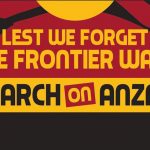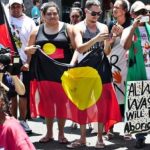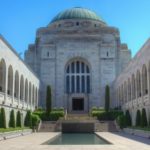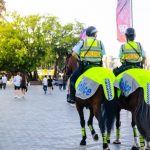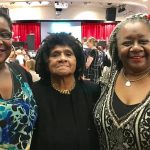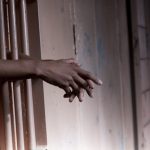The Frontier Wars: The First Defence of Country
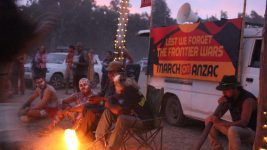
This Thursday, 25 April, marks the ninth anniversary of the annual Frontier Wars March in Canberra. This parade is a commemoration of First Nations resistance to the British invasion of the continent that began in 1788 and continued on in some areas until as late as 1934.
These conflicts were written out of local history books from the late 1900s onwards and only started to re-emerge in Middle Australia over recent decades with the rise of “black armband” historians in the 1960s. Indeed, what prevailed was the myth of peaceful settlement.
This week’s march is part of the ongoing breaking of the silence surrounding the bloodshed that was signature to the British consolidation of power over this landmass. And a key aim is to have this fighting acknowledged in the great sandstone edifice that is the Australian War Memorial (AWM).
Aboriginal Tent Embassy co-founder Ghillar Michael Anderson leads the Frontier Wars March. The Euhaliya elder has explained that it highlights “the wars fought on Australian soil since 1788, when our country was taken by superior force at gunpoint, and those who stood in the way were shot.”
The Aboriginal and Torres Strait Islander procession follows the same route as the Anzac Day parade. And while the crowds gathered in the nation’s capital warmly receive the Indigenous marchers, the local police have a habit of turning them away before they reach the AWM.
Breaking the silence
“Our ancestors were the first to fight and defend this country from invasion,” said Chris Tomlins, an organiser of the Frontier Wars March. “That hasn’t been recognised: our ancestors being the first defenders.”
The Arunta elder said that on Anzac Day, the Gallipoli conflict is referred to as “a defence of this country. But it comes second”. He asserts that what First Nations people want is an acknowledgement that “our ancestors were the first to defend”.
From a remote outstation on the outskirts of Alice Springs, Tomlins is currently in Canberra conducting preparations for the march. On Wednesday, a wreath making workshop will be held, with ornate rings being fashioned out of desert pea flowers: the blood flower of the Frontier Wars.
Every year support for the march has been on the increase, said Mr Tomlins. “This is my fifth year. And it’s just been growing, and the awareness has too. We hope that this year will set the precedent for that acknowledgment.”
The rising toll
Estimates of the numbers that fell during the Frontier Wars have been growing over the decades. In the early 1980s, eminent historian Professor Henry Reynolds calculated that 20,000 First Nations peoples lost their lives during the conflicts. But, over the last decade, he’s upped that to 30,000.
However, some historians have recently estimated that 65,000 Aboriginal and Torres Strait Islander peoples were killed as a result of the conflict in Queensland alone. And this can be compared with the 60,000 Australian soldiers killed during the First World War.
Lest we forget
An early leader of the First Nations resistance was renowned Bidjigal warrior Pemulwuy. He initially led a 12 year conflict that began in 1795 against the encroachment of British settlers along the NSW rivers that are today referred to as the Hawkesbury and Nepean.
The fighting consisted of a series of three wars, fought using guerrilla tactics. Pemulwuy also led a raid on the settlements at Parramatta accompanied by 100 men during the late 1790s. Following his death in 1802, the warrior’s son, Tedbury, took over leadership of the fighting on the river system.
The 1824 Bathurst War was fought between the Wiradjuri nation and the British. The local people carried out raids against the invaders in May, which led them to bring in reinforcements. And the subsequent onslaught perpetrated upon the First Peoples brought the war to an end in September.
The European takeover of the continent was marked by massacres of First Nations peoples. As recently reported in the Guardian, “there were at least 270 frontier massacres over 140 years, as part of a state-sanctioned and organised attempt to eradicate Aboriginal people”.
Knee-deep in lies
Long-term social activist Graeme Dunstan was with Tomlins at the AWM when Sydney Criminal Lawyers spoke to them. The pair were standing before the recently unveiled For Our Country sculpture, which honours First Nations servicepeople who died fighting for the Australian military.
AWM director Dr Brendan Nelson said during his dedication speech at the unveiling that the coming of the British saw a “process of dispossession, violence and brutality,” which was “perpetrated against the First Peoples by pastoralists, police, and at times mounted Aboriginal militia”.
Mr Dunstan recalled that Nelson went onto suggest that this violence and inequality “was all overcome by the Aboriginal servicemen who joined up to defend their country”, as “they won equality and inclusion by this act”.
“This is bullshit. This is lies. It’s a deception to steer people away from the Frontier Wars,” Dunstan said defiantly. “Why can’t they admit the Frontier Wars? They were the biggest wars in this land. In 100,000 years, there had never been a slaughter like this before or a transformation of landscape.”
Despite the growing calls to acknowledge the Frontier Wars at the AWM over recent years, Dr Nelson, a former federal Liberal leader, has continued to maintain that the memorial is only for commemorating Australians deployed overseas, not internal colonial conflicts.
The war continues
According to Tomlins, attitudes in general across the country are changing towards these once forgotten wars. And this shift is further evidenced with the ever-rising support for the “Change the
Date” campaign.
In regard to the frontier conflict, the First Nations activist is clear that the “war is still happening today”. Right now, Aboriginal and Torres Strait Islander peoples are the most incarcerated people in the world, and their children are being removed at unprecedented rates.
“The act of genocide is still happening. And that has to stop. We have deaths in custody. We have an intervention in the Northern Territory,” Mr Tomlins concluded. “These atrocities are still happening. And we’re still suffering.”


